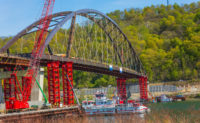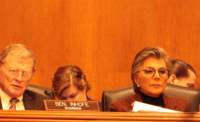Infrastructure
Water Resources Bill Sails Through the Senate
Wide-ranging measure authorizes 30 Corps projects, plus several EPA water programs

Authorized Corps projects include improvements to three Ohio River locks in Pennsylvania.
Credit: U.S. Army Corps of Engineers Pittsburgh District
A new water-resources bill—one of the most important pieces of infrastructure legislation this year—has taken a long stride closer to the finish line: The Senate passed an $11-billion-plus measure authorizing funds for Corps of Engineers and Environmental Protection Agency water projects and programs.
With the Senate’s approval of a Water Resources Development Act (WRDA) on Sept. 15 by a resounding 95-3 vote, construction, engineering, water and transportation officials are turning their focus toward the House. That chamber’s Transportation and Infrastructure Committee on May 25 cleared a smaller, $5-billion WRDA that covers only Corps projects and policies.
House committee Chairman Bill Shuster (R-Pa.) said passing a new WRDA by the end of 2016 is “a top priority.” In a statement after the Senate vote, Shuster acknowledged the “significant differences” between the Senate and House versions.
But he noted that he and key senators had reached deals on past infrastructure bills and added, “We share the same goal of sending a WRDA bill to the president before the end of this Congress.”
The deal isn’t done yet, however: A House floor vote is the next hurdle. That could occur as early as the week of Sept. 19, according to the Senate bill’s manager, Environment and Public Works Committee Chairman James Inhofe (R-Okla.).
Even if the House passes its WRDA before the pre-election recess, a House-Senate conference committee would have to reconcile the two bills' differing provisions. That conference wouldn’t begin until an expected lame-duck session near the end of the year.
The major difference between the bills is scope: The Senate bill, with its Corps and EPA programs, has a price tag of more than $10.6 billion.
The House bill is Corps-only, and its cost would be several billion dollars less than the Senate’s, even after the expected addition of a couple of large projects. It’s unclear whether the House also will add EPA water provisions.
Looking ahead to the conference committee, Mike Strachn, special adviser with Dawson & Associates, says, “I think the biggest significant question mark is, how are they going to bridge that gap?”
Inhofe pledged to continue to support Senate water-system provisions in the conference with the House, especially funding to help cities such as Flint, Mich., whose drinking-water systems have had dire problems.
“I’m guardedly optimistic,” says Strachn, a former Corps official and senior House and Senate aide. He cautions, “It’s not over till it’s over.”
Strachn adds, “And while things look good here on the 15th of September, we all know from experience that things can implode without notice and sometimes unrelated to the merits of the underlying bill.”
The Senate bill authorizes federal funding shares for 30 Corps projects, including flood-and-storm protection, harbor dredging and environmental restoration.
A Senate committee spokesperson said a final cost estimate for the measure wasn’t immediately available. The Congressional Budget Office pegged the cost of the version that Inhofe’s panel approved in May at $10.6 billion. That measure had 27 Corps projects. The bill's authorizations are subject to annual appropriations before funds can flow to construct the projects.
The final bill has three more projects, added in amendment packages in the days before the final vote. Two are the largest projects in the entire bill: southwestern Louisiana coast hurricane and storm protection, with a $2.1-billion federal authorization, and a $1.3-billion authorization for new chambers on three aging locks on the upper Ohio River in western Pennsylvania.
The 30 projects include several for harbor dredging. The American Association of Port Authorities (AAPA) was happy to see other provisions it sought included in the bill. Those provisions include language providing 75% federal funding for dredging navigation channels to 50 ft. At present, the 75% share applies for dredging to only a 45-ft depth. From 45 ft to 50 ft, the federal share now is 50%.
“That’s huge for us,” says Jim Walker, AAPA director of navigation policy and legislation. Ports have been deepening harbors to handle the larger class of ships that use the Panama Canal's expanded third lane. AAPA says the cost share hasn’t changed in 30 years, though there have been “seven generations of container ships” over that span.
Walker, a 36-year Corps veteran, says, “If the U.S. is going to stay globally competitive in freight movement, [ports have] got to get deeper.”
Corps projects have been WRDA centerpieces for decades, drawing support from would-be host senators and House members. They are features of the just-passed Senate WRDA, too. But in a striking break from that pattern, the new measure adds several billion dollars for EPA wastewater-treatment and drinking-water programs.
The Senate bill’s EPA section includes $220 million for Flint and other areas beset by drinking-water problems. Of that sum, $100 million is for drinking-water state revolving funds and $70 million is for federal subsidies to support at least $700 million—and perhaps as much as $4.2 billion—in federal Water Infrastructure Finance and Innovation Act (WIFIA) loans.
The Senate legislation also provides $1.4 billion over five years to help small and disadvantaged communities meet Safe Drinking Water Act requirements, plus $300 million to replace lead service lines and deal with related uses.
The National Association of Clean Water Agencies hailed the bill's drafters for making "significant new investment for clean water and providing stronger tools to help communities afford this infrastructure," NACWA CEO Adam Krantz said in a statement. He cited provisions such as the reauthorization of EPA's sewer-overflow-control grant program at $1.8 billion over five years and a permanent authorization for WIFIA.
Krantz also pointed to what may be the legislation’s most dramatic new program: a trust fund for clean- and drinking-water infrastructure. There was no cost estimate for that fund, but a summary of the bill says its revenue would come from “fees collected for a voluntary labeling system.” Further, the bill would establish national drought-resilience guidelines.
It also would provide $1.5 billion over five years for the Great Lakes restoration plan. Restoration programs for other bodies of water, including Lake Tahoe, Long Island Sound, and the Delaware and Columbia river basins, would receive a total of about $1 billion.
Industry officials were pleased, but environmental groups were unhappy with a regulatory provision added during the floor debate period that allows states to establish permitting systems for the use of coal ash, subject to EPA approval.
Coal ash’s uses include construction materials. EPA in December 2014 issued a regulation governing the use of coal ash.
The Edison Electric Institute, which represents utility companies, welcomed the Senate bill and called the coal-ash provisions “critically important.” But the Environmental Integrity Project and the Waterkeeper Alliance say the bill’s language would “undercut” the key provisions of EPA’s 2014 regulation.
Industry officials also are pleased that the action on a new WRDA holds out the prospect of returning to a practice of enacting such legislation every two years. The last WRDA was signed in 2014, but the one before that became law in 2007.
John Doyle, special counsel with law and lobbying firm Jones Walker LLP, says that, generally, WRDAs were biennial in the late 1960s and early 1970s. There were seven WRDAs from 1988 to 2000, he notes.
AAPA’s Walker says, “For us, probably the biggest thing is that return to ‘regular order,’ getting us back to two years.”
Strachn says the two-year cycle gives agencies and industry “some dependability to point to, whether it’s scheduling business models or programming within the Corps of Engineers.”




